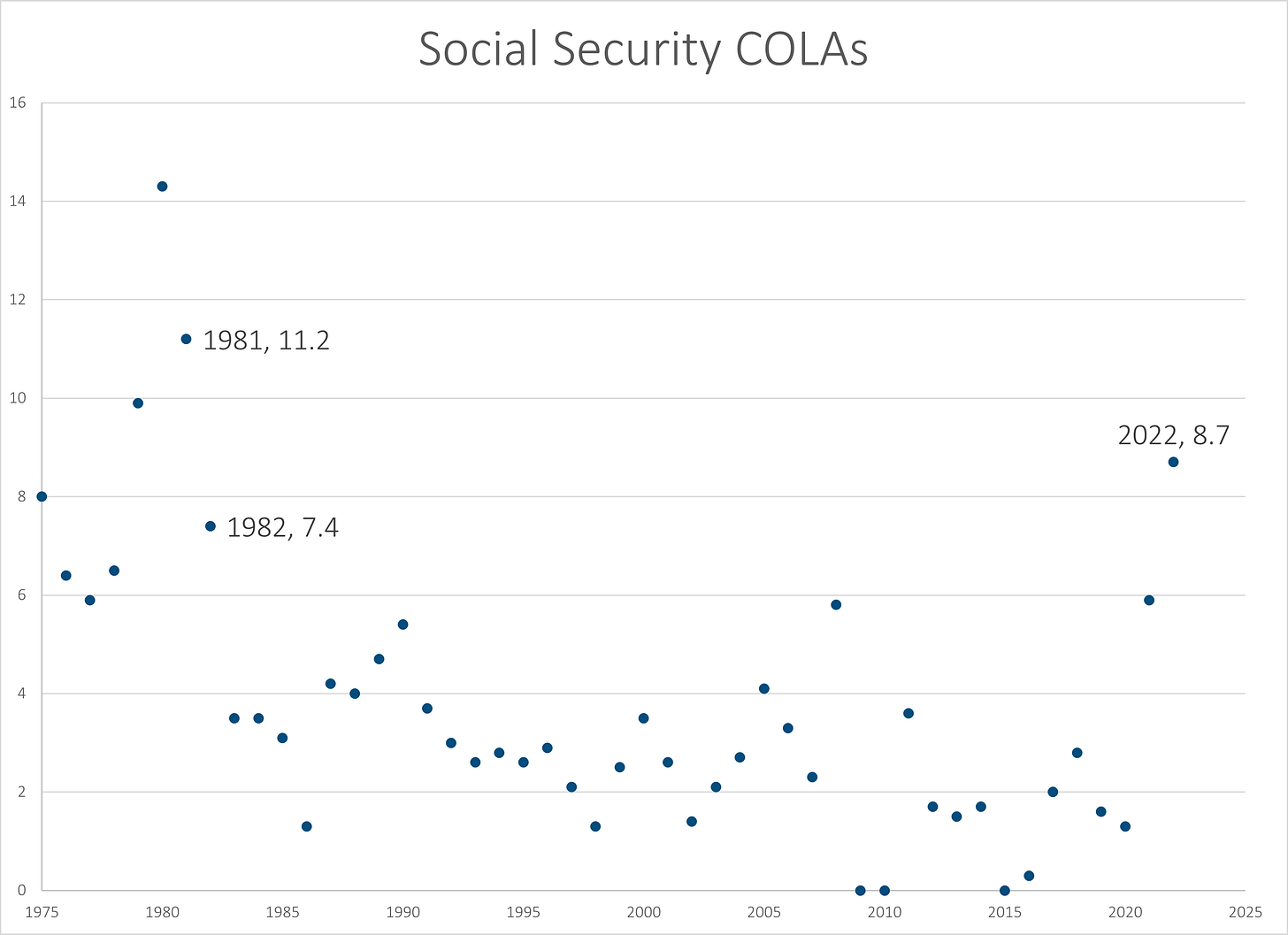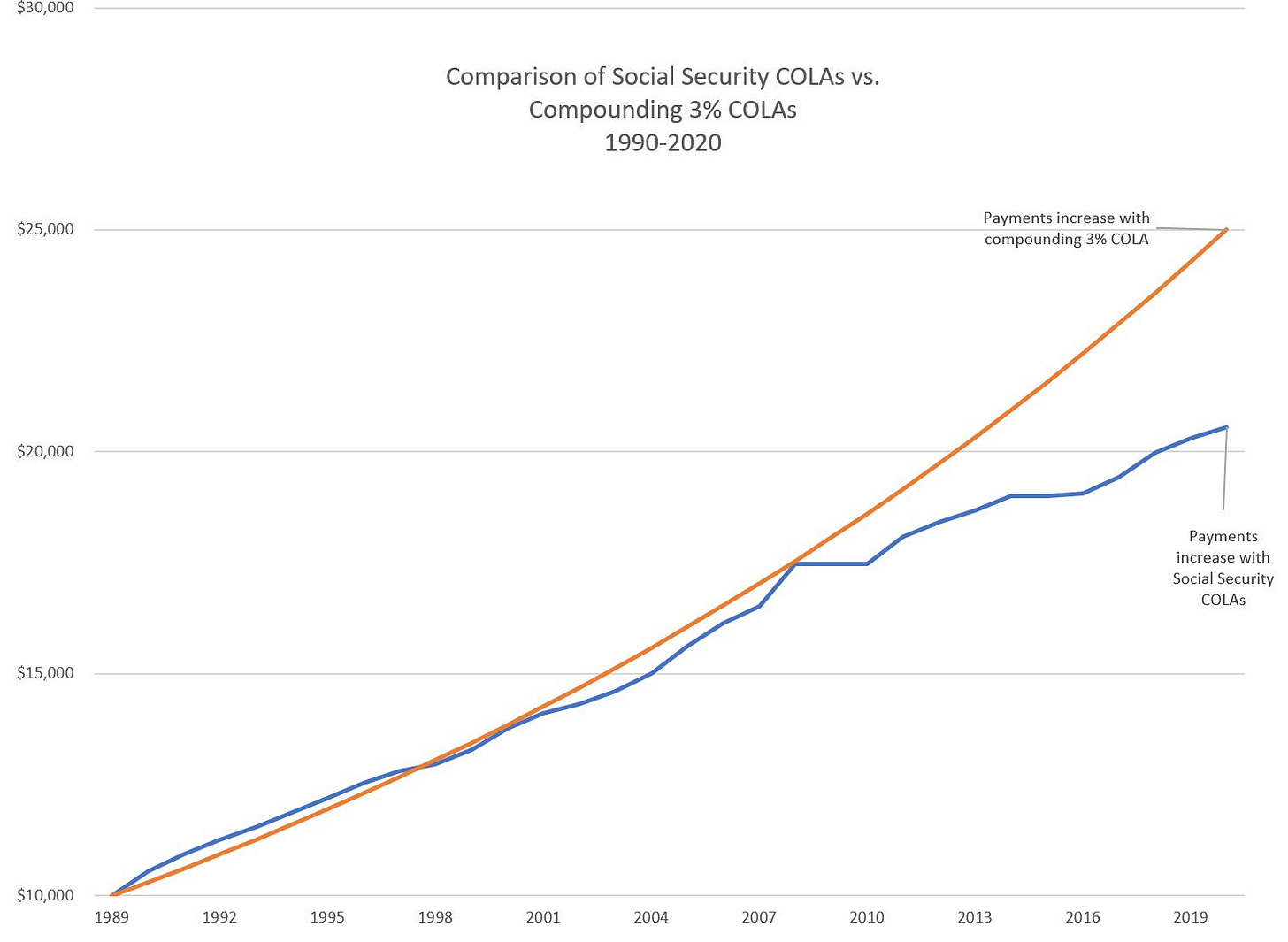Choices Have Consequences: Retirement Benefit Design - COLAs, Replacement Rate, Indexing, and More
Promising more doesn't mean people will actually get more
In my prior post in this series, I discussed retirement age and retirement policy.
Retirement age is a crucial decision in designing a pension plan or other retirement benefits — but there are many more choices to be made — not just what age at which you’re eligible to take benefits, or the age at which you’re “expected” to retire (and then adjusting benefits up or down if you retire after or before that age), but also the level of benefits you will get as a base, whether those benefits will get adjusted once you’re in retirement (COLAs — cost-of-living adjustments), how much is guaranteed and how much is variable, and more.
There are some simple principles — basically, the more you promise, the more expensive it will be.
Also, if you do not put aside money for those promises, the more hollow those promises ring.
But perhaps I will leave that lesson for my post (upcoming) on whether one actually pre-funds retirement benefits.
What are the consequences of overpromising retirement benefits?
It’s not a difficult concept, but there are so many “clever tricks”, of which we will see a few hand-wavy examples in upcoming posts (and several in past posts that I will link to at the bottom), where the fact that many of these promises are extremely expensive to try to render them super-easy to handle, barely an inconvenience….
….until decades later and a demographic pile-up occurs and a bunch of cash is flowing out of the pension funds, Social Security Trust Funds, and it has become very clear that this state of affairs cannot continue and those promises may need to be rescinded.
To prioritize the type of promises being made, let’s look at Social Security first.
Initial Social Security Benefits When You Retire — Based on Indexed Earnings
Let’s take a look at the explanation of how the initial benefit is calculated:
Social Security benefits are typically computed using “average indexed monthly earnings.” This average summarizes up to 35 years of a worker’s indexed earnings. We apply a formula to this average to compute the primary insurance amount (PIA). The PIA is the basis for the benefits that are paid to an individual.
The formula used to compute the PIA reflects changes in general wage levels, as measured by the national average wage index.
It gets really complicated, with bend points, to reduce the effects of higher wages.
For those like me who earn above the wage base, only our earnings up to that base count. But the benefit is (still) based on earnings so people with higher earnings get a higher Social Security benefit with the current formulas. But due to the bend points, those with higher earnings will get less of a benefit in comparison to their “contributions” (aka taxes) they had paid over the years.
However, the indexing of the wages and averaging the earnings tracks a trajectory over a person’s working lifetime, as opposed to how many public pension defined benefit plans work, which will have benefits based on the last few years of salary instead of the whole working history.
Rather than doing the calculation, which you can see here for indexing, and here for PIA, I am going to look at the “replacement rate” for Social Security retirement benefits.
The SSA has a page where it regularly publishes current projections of replacement rates, which is how the Social Security benefit compares against the indexed earnings.
I’ve taken a selection of results from the March 2023 report, selecting those who retire at their full retirement age in 2023:
I will note that the maximum initial Social Security benefit in this example is 3.5 times that of the lowest shown. That lowest one shown, with a 78% replacement rate, is a situation where the person has an indexed earnings history of $16K/year. Given that Social Security was established to reduce senior poverty, it does make sense to have a higher replacement rate for those with lower earnings history.
However, we’ve got other moving parts of Social Security – namely, after the initial benefit is set, it gets adjusted — many public pensions also have this — and we call these COLAs (cost-of-living adjustments).
COLAs don’t refresh when the money is running out
Once upon a time, increases to Social Security benefits to those already receiving them were done on an ad-hoc basis, but there had been some nasty inflation in the 1970s, and Congress got a bit tired of having to deal with these adjustments themselves and then made the increases automatic. So we have a history of these automatic increases going back to 1975:
I had a podcast episode on Social Security politics:
Perhaps inflation will have come down again, but note that in those years where the specific index would have been negative, the payments don’t go down. As with public pensions, in general, the benefits can only be ratcheted upwards.
With the increase in inflation, the cash goes out faster. As noted on this page, new beneficiaries tend to have higher benefits to begin with, the effect of the indexed income, and then one has older beneficiaries die off, so average benefits being paid out grow faster than the COLAs.
And, of course, Social Security is not the only program with problems.
Cash running out all over – and inflation doesn’t help
Back in 2020, before we hit all this high inflation, I compared Illinois’s steady 3% COLA against Social Security’s COLA tied to actual inflation:
From 1990 to 1998, the Social Security COLA effect exceeds that of the 3% constant COLA… and from 1998-2008, the payments stay pretty close.
But after 2008, the paths clearly diverge.
After 31 years of constant 3% COLAs, the initial payment has inflated into 2.5 times the original amount. That’s the magic of compounding, after all.
Given the inflation history, a constant 3% COLA didn’t sound outrageous in 1990, but it has really added up over the decades.
The Social Security amount more than doubled over the same period, but the constant 3% compounding leads to a payment of more than 20% than the Social Security COLAs compound to. That comes from an average 2.35% growth rate on the Social Security payments over 31 years versus 3% per year for 31 years.
It’s interesting. For many years, there had been minimal actual inflation in the outside world, but these level, compounding COLAs had been ticking away in Illinois, eating away at the fundedness of Illinois pension funds.
So now, when retirees could really use a hefty COLA… the pension funds really can’t afford it.
Just pulling from Illinois’s largest pension fund, Illinois Teachers Fund:
Funded status:
Contribution rates:
The fund is very underfunded, they are contributing too little, and they’re barely moving the dial with respect to fundedness. They can ill afford to give retirees more now, when the retirees would need it. Because they gave retirees more money during times when it wasn’t needed.
The result for distressed systems: the promises aren’t fulfilled; the deals are altered
NASRA has a good issue brief on COLAs in public pensions, which includes a long appendix detailing the COLAs by plan, and also describes COLAs that have been changed:
As part of efforts to contain costs and to ensure the sustainability of public pension plans, and in response to a period of historically low rates of inflation that lasted for over a decade during and after the Great Recession, many states have made
changes to COLA provisions by adjusting one or more of the COLA design elements mentioned above5 (see Figure 2). As described in Appendix A, since 2009, 17 states have changed COLAs affecting current retirees, eight states have addressed current employees’ benefits, and seven states have changed the COLA structure only for future employees. The legality of these modifications in several states has been challenged in court, as noted in Appendix A.In most cases, changes to COLA provisions require an act of the legislature and approval of the governor. However, in some cases retirement boards have been vested with the authority to enact COLA reforms; this authority has been exercised in three states – Maine, Missouri, and Ohio – since 2016. As noted above, most COLA changes affecting current retirees were subjected to legal challenge. Legal rulings issued in recent years upheld COLA reductions passed in New Jersey, and several other states, and fully or partially rejected COLA reductions approved in Illinois, Montana, and Oregon. A 2015 legal settlement pronounced material changes to COLA provisions for public employees in Rhode Island.
Some states that do not provide an automatic COLA have responded to recent higher rates of inflation by granting an ad hoc COLA for most retirees. Prior to granting their most recent COLA, some of these states, which includes Alabama, Georgia, New Hampshire, Oklahoma, Texas, and others, had not granted a COLA for several years when inflation was lower.
I kept track of the Rhode Island and New Jersey situations for a while – two states with very strained finances. But they’re not the only ones, as seen in the paper’s Figure 2:
If you’re a retiree, and you see your benefits change in nature while you’re in retirement, you’re going to be very unhappy. The deal has been altered.
But nobody wants to be that politician having to reduce the money being paid, because it’s very unpleasant — you want somebody else to be the bad guy. That said, when one is looking at the cash going out:
Unlike the federal government, which can let the money printers rip (at least for a while), the states are more constrained in calling money into being.
Not all the states, cities, etc. have overpromised on pensions. The more modest the promises, the easier it has been for them to fulfill those promises.
But many of the programs we’ve seen under stress are chock-full of features that increase benefit values, such as COLAs and initial benefits to retirees. If you have promised benefits growing faster than the revenues that are intended to support those benefits… well, there are consequences to that.
Some people argue that we don’t have to fully fund public pensions (that will be the next post) and others think we can reduce the pension costs via clever investing (also upcoming) or that overly-complicated investing is the reason that pensions have been sunk. We will see.
But much of this, driven by lengthening lives, fewer people coming after, and then promising benefits that grow faster than the base that can support these promises — the core logic is obvious.
Some promises could be made, and some places have been successful.
If you want to see a deeper dive on these issues, here is my older post from November 2018: A Proposal: Restructuring Current Public Pensions Through Municipal Bankruptcy, about a paper I co-wrote with W. Gordon Hamlin, Jr. I embedded the paper via scribd, but it may be easiest to access the paper via my Dropbox.
Some of that is about trying to be blind to the core logic — that these promised benefits are very valuable promises. The various tricks are done to try to make them seem less valuable than they actually are.
That doesn’t make the promises actually cheaper, and it certainly doesn’t make them more likely to be fulfilled.













